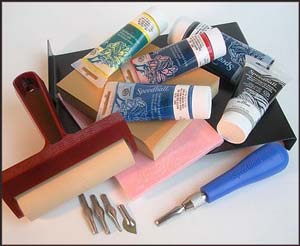
If you’re a fan of art crafts, then you’ll love block printing. To make it happen, however, you need to have the right block printing supplies.
We know it can be hard to find the right supplies when you know little to nothing. So we decided to make a list of the most essential items to consider. But first – let’s go a little deeper into block printing.
What Is Block Printing?
If this is the first time you hear about it, then you may want to know that it refers to a crafting technique using wood and ink.
With wood and ink, it is possible to make stamps, relief printing, linocuts, and rubber stamping. As long as you have a block of wood, linoleum plate, or a rubber stamp – then you can print something on it and create art.
To give you a better idea, block-printing comes from Japanese culture. People used it to create art like “The Great Wave off Kanagawa,” the “Plum Garden in Kameido”, and even the “Bathhouse Women.”
This art can last centuries, depending on what supplies you use. If you want to make something similar that possibly goes down in history as one of the greatest pieces of art –block printing is for you. So let’s explain what supplies you need to get the most out of your block printing:
1. Blocks & Linoleum
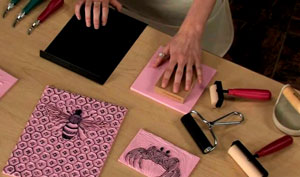
First and foremost, you need to get a block to make the print. This could be anything from softwoods to hardwoods, plywood, MDF, linoleum, or sure enough, rubber. The results and use will be different. So you need to know what to go for before making a final choice. Here’s a better idea of what each one offers:
Wood Blocks
Among the many types of woods you can use, there are softwoods like cedar, pine, and poplar. Then you find hardwoods like birch, ash, and cherry. And finally, you find wood alternatives like plywood or MDF.
It is important to know that softwoods are easier to carve than hardwoods, but they also hold the print for less time and can be too fragile for the most complex prints.
A piece of hardwood, on the other hand, is made to last. It will be more challenging to make a print on hardwoods, but they hold the print for longer and do not break/tear in the process.
If you don’t want to use softwoods or hardwoods, then MDF or plywood can be more affordable choices. However, both of these options are even more fragile than softwoods and slightly more difficult to use.
For example, MDF tends to crack pretty easily. If you aren’t careful, you may break an MDF block by mistake. And because MDF doesn’t have grain, it is harder to leave a print and/or detail its surface.
Plywood, on the other hand, is harder and more resilient. It won’t break easily, thanks to its sturdy composition. At the same time, plywood has grain, so it can handle a decent amount of detail. The right type of plywood may even offer an extra smooth surface, making every print even easier to make.
Rubber Blocks
If a wooden block feels too expensive or unnecessary, then you can go for rubber blocks. These are specially made for carving and stamping, making them almost perfect for block printing.
The advantage of a rubber block is how soft they are. This allows effortless carving, while still allowing excellent detail in print.
But because the rubber is so soft, messing up the print is also easier. If you’re not careful, you may end up carving more than necessary. And this can mess up the whole block.
Overall, rubber blocks are excellent for stamping. But they work for standard printing as well.
Linoleum
Also known by its more popular name, lino, it was created with the sole purpose of working as a floor cover. But thanks to its sturdiness and design, linoleum pieces can also be used for block printing.
This material has one of the smoothest surfaces in the market. But the material is somewhat tricky to carve on. Using lino is not a piece of cake, but it is still one of the most affordable you can get for the quality.
It delivers exceptional detail while making stamping, and other printing methods look superb. With large pieces, you can make long-lasting pieces of art. And with small linocuts, you can make stamps and the like.
To carve lino, however, you may need special knives or gouges. It is like carving on hardwoods, so it also requires some patience and time. But due to the smooth surface it offers, it also leaves a lot more space to mistakes – so it should be done with extra care.
Overall, lino is ideal for most people who want an affordable yet long-lasting piece. But be aware that it is not easy to carve on.
2. Carving Knives & Gouges
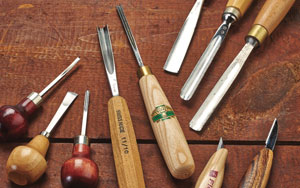
Once you have a block to carve, then you need the carving tools. Here’s where the knives and gouges enter into action.
A carving knife refers to a small blade with a specific shape that makes cutting wood easy. This blade can hold different shapes and sizes. The sole purpose of these small blades is to achieve more detail in the piece. Most knives are used for detailing instead of removing wood.
Gouges, in contrast, are for removing large pieces of wood. Still, they also come in different shapes and sizes, so you can decide how much material to remove according to your needs. Some of them are V-shaped for straight cuts, while others are U-shaped for rounded cuts.
If you’re going to do some block printing, then you’ll need carving knives or gouges to get the design/print you’re looking for in the block.
3. Brayer or Roller
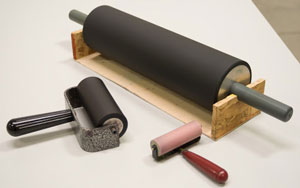
Once you’ve done the carving on the block, then you need to pour some ink on it. But pouring alone won’t do the job – as you will end up wasting ink and messing up the whole print in the end.
That’s why you need to use a special tool called brayer. It is also known as the roller, and its sole purpose is to help spread ink on the block.
Thanks to the softness and design they offer, you can use them to spread the ink uniformly. This eventually helps to achieve better prints and prevent gloomy or messy prints on any surface.
4. Block Printing Ink
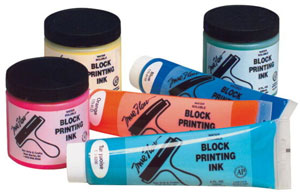
But how can you spray ink with a brayer if you don’t have the ink?
That’s where the printing ink comes into play.
This ink is not like any other ink out there. You may find it as block-printing ink, or solely as printing ink. It needs to have a specific consistency and thickness, so it can adhere appropriately to most surfaces, including fabric and paper. This printer ink remove from carpet post has some additional tips to remove printer ink easily.
At the same time, this ink needs to be water-soluble, so cleaning it from the block (rubber, wood, or linoleum) doesn’t take much time or effort. Sure enough, you’ll find this ink in a wide array of colors.
5. Baren or Press
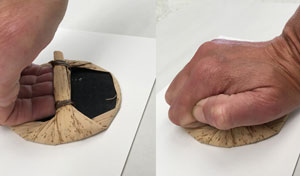
Last but not least, you need an additional printing supply called the baren. This is the piece you need to place on top of the linoleum, wood, or rubber block.
What this support does is press the block into a surface whenever you’re printing something. Just after spraying a block with ink, you’re ready to press it over the surface. Well, the baren is what you use to print the thing.
Baren are special because they provide more uniformity and properly distributed pressure without causing damage to the block. While you may also use things like spoons, books, or other blocks – nothing compares to a baren or press.
Set up Your Block Printing Supplies Now!
If you’re looking to start some block printing, then you need all the necessary supplies. Luckily, they aren’t that many or expensive.
So, if you need block printing supplies to start printing attractive and durable designs on fabric, wood, paper, or any other surface – then follow this guide to the letter. You won’t miss a thing!
Related Post: